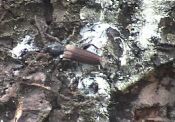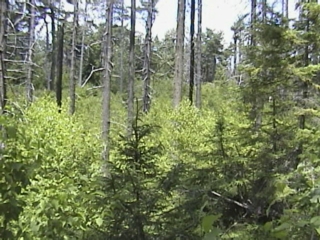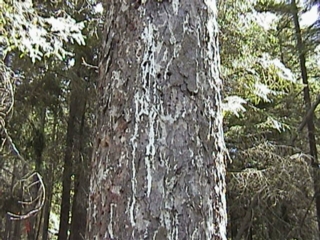
Tetropium fuscum.

The response to borer beetles in Halifax's Point Pleasant Park could be a timely effort to avert tragedy, or another act in a political drama.
 |
| The Brown Spruce Longhorn Beetle Tetropium fuscum. |
If recent media coverage of the Brown Spruce Longhorn Beetle is any indication then the dangerous wood-boring beetles recently been discovered in Point Pleasant Park in Halifax are rapidly destroying the forest and threatening to take a huge bite out of the North American forest industry. Time is of the essence and over 10,000 trees will rapidly have to be cut.
However, is there really a problem and if so what is it? Government, environmental groups, scientists and citizens all seem at loggerheads.
In 1990 biologist Stephanie Robertson found 17 Brown Spruce Longhorn Beetles (Tetropium fuscum) in the Park, an 80-hectare civic park that covers the southern tip of peninsular Halifax, as part of a study on bark beetles. They were then believed to be the very similar and closely related native species (Tertropium cinnamopterum) and were not recognized as interlopers. Dr. Edith Angelopoulos, an entomologist from Dalhousie University feels that they may have been present for some time. "No one had ever looked for them."
"Halifax has been a port for 350 years," adds biologist Andrew Hebda of the Nova Scotia Museum of Natural History. "There could have been many opportunities for this beetle to arrive here."
Then in 1999 the Canadian Forest Service (CFS), investigating diseased Red Spruce in the Park, found some 43 individuals. Recent surveys by the CFS over the past several days have turned up beetles in 23 additional localities in the metro area.
In the park they join a number of native species of wood-boring beetles including the Pine Stump Borer (Asemum striatum) and the Ribbed Pine Borer (Rhagium inquisitor). The larvae of these beetles burrow in the wood of affected trees, just under the bark. The adults emerge through small holes during the late spring and summer to reproduce. Signs of injury to the trees - streams of resin on the trunk and small holes in the bark - can be caused by any of these beetles, or others that may be present. External damage to trees, while indicative of a problem, can not pinpoint a particular insect responsible.
 |
| Monochamus scutellatus, another common Longhorn Beetle in NS . |
David McCorquodale, a biologist at the University College of Cape Breton, an expert on wood-boring beetle has so far found 95 species of this family (Cerambycidae) of wood- boring beetles in Nova Scotia, and there are other wood-boring and bark-burrowing beetles found in the province as well. Ms. Robertson found 19 species in Point Pleasant Park.
While previously unknown here, this beetle has been extensively investigated in Europe where many studies have shown that they attack primarily diseased or dying trees, not healthy ones. A Czech study by Dr. Michael Kudelka in 1970 found them in trees "weakened by short-term drought, honey fungus or red rot." The Norwegian Forest Research Institute has concluded that, "It's attack on a living forest is also of small importance. Trees that are chosen are as a rule highly weakened, and many will surely die of other causes even if the bark beetle doesn't establish itself there."
A recent synopsis of its biology by Erhard Dobesberger of the Canadian Food Inspection Agency (CFIA) notes that, "Typically, windthrown trees, lightning damaged trees, trees exposed to fire and freshly cut logs are attacked." Dr. Hugh Evans, Principal Entomologist in Forest Research with the British government, says, "It seems unlikely that the beetle will cause direct tree mortality in Canada since, in the great majority of cases, longhorn beetles do not act as primary tree killers."
"The beetles feed only on dead and dying trees in Europe," says Dr. Angelopoulos. "There is no reason to suppose they will behave any differently here."
The CFIA Task Force overseeing the situation has been claiming otherwise, arguing that in Nova Scotia the beetles have shifted their diet to healthy trees. This is a crucial point since the CFIA believes that wood-boring beetles are the cause of unhealthy trees in Point Pleasant Park, and hence provides the rationale for why the agency proposes to cut 10,000 in an extermination attempt. This is in contrast to most of the scientific research that has been done, which indicates that the presence of these wood-boring beetles is simply a symptom of fundamental ill health of a tree and, in later stages, part of the natural decomposition process.
 |
| A clearing in Point Pleasant Park with several dead Red Spruce. |
In Point Pleasant Park wood-boring beetles are found on older and quite unhealthy Red Spruce and seldom on trees with substantial living foliage. Andrew Hebda points out that in surveys of infestation younger and smaller trees are completely without signs of infection. What, then, might be the cause of this unhealthy forest?
A number of factors have been implicated including, perhaps most importantly, disturbance to the forest floor and soil ecology due to a decades-long policy of clearing underbrush from the park and the removal and burning of fallen trees, an approach which even the Park's Commission itself has called "heavy-handed." Many biologists feel that this has created significant nutritional impoverishment of the soil. Stephanie Robertson's study a decade ago warned; "Continuous removal of whole trees over time prevents natural return not only of nutrients but also of organic matter. The downed and felled trees in Point Pleasant Park are returning neither nutrients nor organic matter to the park's soil."
Robertson feels that a key component of the beetle infestation problem may have been the practice of storing cut logs at a site in the center of the Park. "Cut lumber is well known to attract wood-boring beetles and almost all the worst affected areas in the park are directly down-wind from this storage site."
 |
| Ill Red Spruce exhibiting resin flows. |
Other factors such as over-use of the park (which now receives in excess of 1.4 million visits a year), air pollution, soil compaction, and several years of drought, which can cause severe water stress to larger trees, have all been implicated. Retired biology instructor Jim Wolford says, "The claim that 'healthy red spruces' are being attacked seems to have little or no evidence. Those Park trees have been stressed for a long time by various forms of mismanagement, heavy uses of the ground, heavy fertilization and salt-spray."
Lary Brown, a heritage resources management specialist and an observer on the task force, argues that this situation should serve as a wake-up call for Haligonians who care about their park to recognize that there are environmental problems that require attention, resources and commitment before the park can be restored to some semblance of a natural state of health.
The CFIA, however, is taking very rapid action. A Formal environmental assessment process has not been undertaken. Tenders have already been issued for the cutting, and work might commence in a matter of days. In the face of questions as to what if any threat is posed by the beetle, why are officials anxious to move so rapidly?
Some critics have suggested that the Nova Scotia forest industry is alarmed that if they are not seen to be moving with sufficient alacrity on the issue, it could be taken up by American lumber interests, involved in the $30 billion Canada-US softwood lumber trade, in order to call for sanctions against Canadian lumber products. True or not there is the apprehension by many Halifax residents that the forests of Point Pleasant Park may have become entangled in a larger political drama.
The Park is home to the popular theatre company, Shakespeare in the Park. Audiences this summer may find new resonances in the Bard's words from Measure for Measure:
"The sense of death is most in apprehension, and the poor beetle, that we tread upon, in corporal sufferance finds a pang as great as when a giant dies."
National Post
July 11, 2000
[Home] [Press Releases] [History] [Get Involved] [Photo Gallery] [Links]